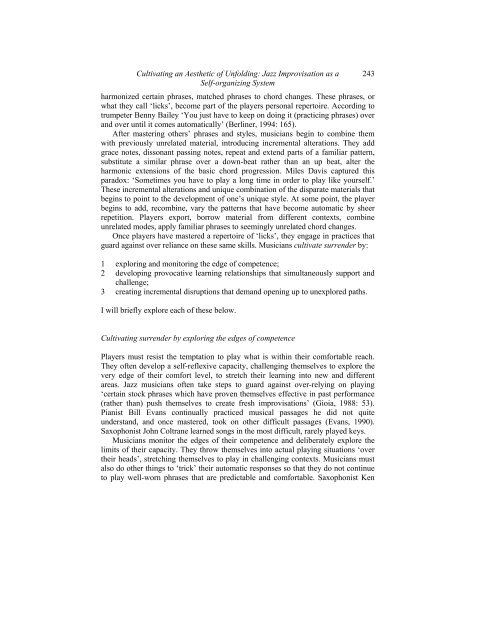Cultivating aesthetics - iSites
Cultivating aesthetics - iSites
Cultivating aesthetics - iSites
Create successful ePaper yourself
Turn your PDF publications into a flip-book with our unique Google optimized e-Paper software.
<strong>Cultivating</strong> an Aesthetic of Unfolding: Jazz Improvisation as a<br />
Self-organizing System<br />
harmonized certain phrases, matched phrases to chord changes. These phrases, or<br />
what they call ‘licks’, become part of the players personal repertoire. According to<br />
trumpeter Benny Bailey ‘You just have to keep on doing it (practicing phrases) over<br />
and over until it comes automatically’ (Berliner, 1994: 165).<br />
After mastering others’ phrases and styles, musicians begin to combine them<br />
with previously unrelated material, introducing incremental alterations. They add<br />
grace notes, dissonant passing notes, repeat and extend parts of a familiar pattern,<br />
substitute a similar phrase over a down-beat rather than an up beat, alter the<br />
harmonic extensions of the basic chord progression. Miles Davis captured this<br />
paradox: ‘Sometimes you have to play a long time in order to play like yourself.’<br />
These incremental alterations and unique combination of the disparate materials that<br />
begins to point to the development of one’s unique style. At some point, the player<br />
begins to add, recombine, vary the patterns that have become automatic by sheer<br />
repetition. Players export, borrow material from different contexts, combine<br />
unrelated modes, apply familiar phrases to seemingly unrelated chord changes.<br />
Once players have mastered a repertoire of ‘licks’, they engage in practices that<br />
guard against over reliance on these same skills. Musicians cultivate surrender by:<br />
1 exploring and monitoring the edge of competence;<br />
2 developing provocative learning relationships that simultaneously support and<br />
challenge;<br />
3 creating incremental disruptions that demand opening up to unexplored paths.<br />
I will briefly explore each of these below.<br />
243<br />
<strong>Cultivating</strong> surrender by exploring the edges of competence<br />
Players must resist the temptation to play what is within their comfortable reach.<br />
They often develop a self-reflexive capacity, challenging themselves to explore the<br />
very edge of their comfort level, to stretch their learning into new and different<br />
areas. Jazz musicians often take steps to guard against over-relying on playing<br />
‘certain stock phrases which have proven themselves effective in past performance<br />
(rather than) push themselves to create fresh improvisations’ (Gioia, 1988: 53).<br />
Pianist Bill Evans continually practiced musical passages he did not quite<br />
understand, and once mastered, took on other difficult passages (Evans, 1990).<br />
Saxophonist John Coltrane learned songs in the most difficult, rarely played keys.<br />
Musicians monitor the edges of their competence and deliberately explore the<br />
limits of their capacity. They throw themselves into actual playing situations ‘over<br />
their heads’, stretching themselves to play in challenging contexts. Musicians must<br />
also do other things to ‘trick’ their automatic responses so that they do not continue<br />
to play well-worn phrases that are predictable and comfortable. Saxophonist Ken
















